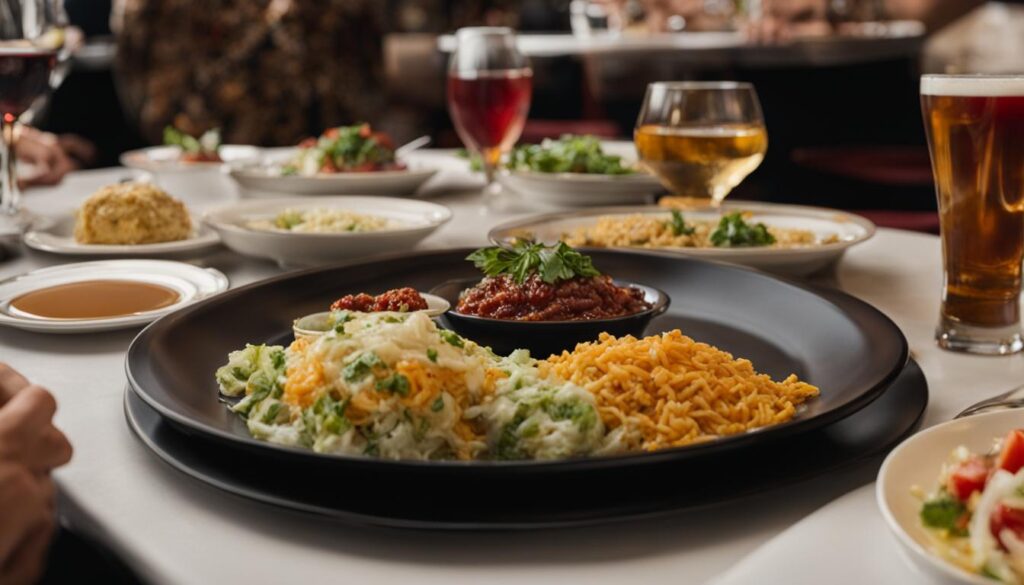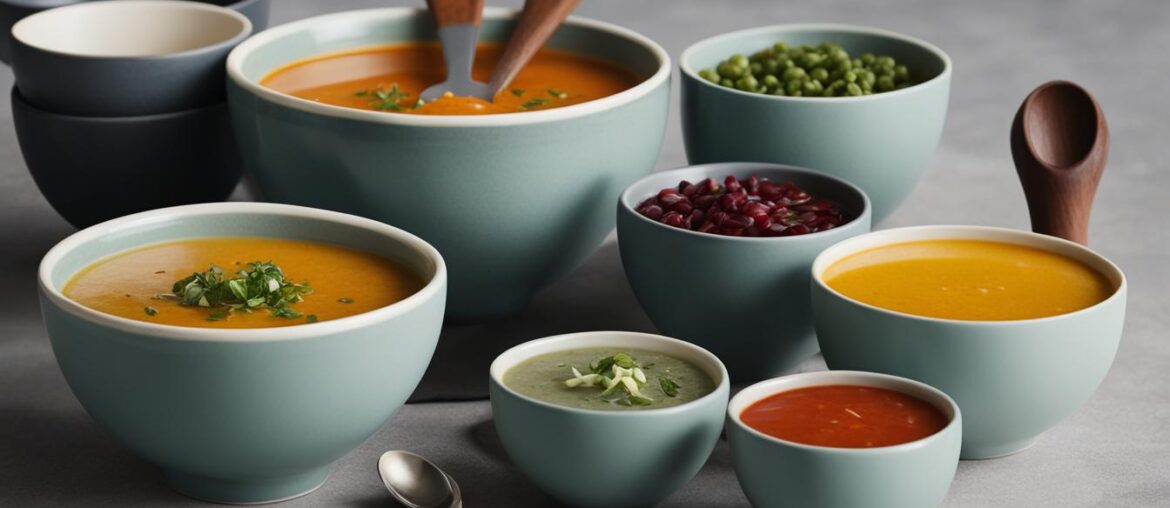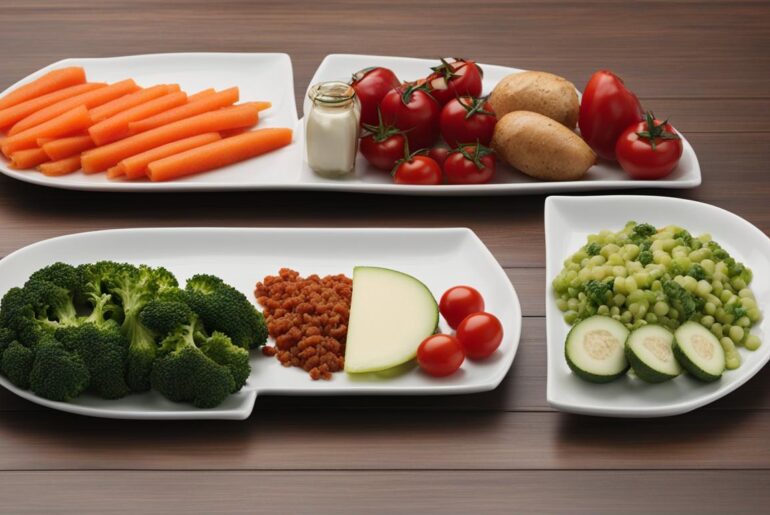In our modern society, many people struggle with controlling portion sizes, especially when it comes to soup. However, mastering soup portion control is essential for maintaining a healthy lifestyle. In this comprehensive guide, I will provide you with practical tips and strategies to effectively portion control your soup. By understanding the importance of portion sizes and learning various techniques, you can make conscious choices about your soup consumption and promote overall well-being.
Key Takeaways:
- Learn how to portion control soup for a healthier lifestyle.
- Discover effective techniques and strategies for managing soup portion sizes.
- Understand the impact of portion sizes on calorie intake.
- Explore estimation challenges and tools for portion control.
- Get tips for estimating portion sizes at home and while eating out.
Understanding the Importance of Portion Sizes
When it comes to maintaining a healthy lifestyle, understanding the importance of portion sizes is key. The impact of portion sizes on calorie intake cannot be overstated. Consuming larger portions than necessary can lead to excess calorie consumption and potential weight gain. It’s essential to master portion sizes to have better control over your calorie intake and make conscious choices that support your health goals.
To illustrate the significance of portion sizes on calorie intake, let’s consider an example:
Imagine you’re enjoying a comforting bowl of soup. The recommended portion size for that particular soup is one cup. However, if you pour yourself two cups of soup, you’re unknowingly doubling your calorie intake. By being mindful of portion sizes, you can reduce your calorie consumption and maintain a healthier balance.
The Impact of Portion Sizes on Calorie Intake
Portion sizes directly affect the number of calories you consume. Overeating larger portions can lead to calorie surplus, which can contribute to weight gain over time. On the other hand, by controlling portion sizes, you can regulate your calorie intake and manage or even reduce your weight.
Here’s a breakdown of the potential impact of portion sizes on calorie intake:
| Portion Sizes | Calorie Intake |
|---|---|
| Smaller Portions | Lower Calorie Intake |
| Larger Portions | Higher Calorie Intake |
As you can see, by consciously choosing smaller portion sizes, you can effectively reduce your calorie intake and create a calorie deficit.
Controlling portion sizes plays a vital role in maintaining a healthy weight and preventing overconsumption of calories. By understanding the impact of portion sizes on calorie intake, you can make informed choices and take control of your overall health.
The Challenge of Estimating Portion Sizes

Accurately estimating portion sizes can be quite the challenge, particularly when dining out or relying on visual cues. However, developing estimation skills is vital for maintaining portion control in various settings. In this section, we will explore practical techniques and tools that can help you estimate portion sizes more effectively, both at home and when eating out.
“Estimating portion sizes accurately is crucial for maintaining a healthy diet. However, it can be difficult when we are faced with an abundance of food options or unfamiliar serving sizes. By learning how to estimate portion sizes, you can make informed choices and avoid overeating.”
When dining out, the lack of pre-measured portions can make it challenging to gauge the right amount of food to consume. Whether it’s a restaurant dish or a buffet, determining how much you should eat can be overwhelming. Additionally, visual cues can be misleading, with portion sizes appearing larger or smaller than they actually are.
At home, serving sizes may be influenced by habit or subjective judgment, leading to inconsistent portion control. This can especially be a concern when it comes to foods that are calorie-dense, like soups or desserts.
Estimating portion sizes accurately requires practice and awareness. By implementing the following techniques and utilizing helpful tools, you can overcome the challenges and make more informed choices:
- Use portion control aids: Measuring cups, kitchen scales, and portion control plates can provide a tangible reference point for portion sizes (check this post out). These aids allow you to measure and visualize how much you are consuming, helping you become more accurate in your estimations.
- Educate yourself: Familiarize yourself with recommended serving sizes for different foods. This knowledge can serve as a guide when estimating portion sizes in the absence of measuring tools.
- Compare to familiar objects: Use familiar objects as a visual reference to estimate portion sizes. For example, a deck of cards can be roughly equivalent to a serving of meat, or a tennis ball can represent a serving of fruit.
- Practice mindful eating: Pay attention to your body’s hunger and fullness cues. By eating slowly and savoring each bite, you can better gauge when you have eaten enough, preventing overeating.
Estimating portion sizes accurately takes time and practice. It’s important to be patient with yourself as you develop this skill. Remember, consistency is key, and over time, you will become more proficient at estimating portion sizes, allowing you to maintain better portion control and support your goals for a healthy lifestyle.
Estimating Portion Sizes at Home
When it comes to portion control at home, having the right tools and techniques can make a significant difference in managing your food intake effectively. By utilizing nutrition labels, measuring cups, visual comparisons, and considering plate size, you can estimate and control portion sizes with greater accuracy.
Utilizing Nutrition Labels: One helpful tool for portion control at home is the nutrition label. Pay attention to the serving size mentioned on the label, as it provides valuable information about the appropriate portion size. Use this as a guide to portion your meals accordingly.
Measuring Cups: Measuring cups are a reliable tool for estimating portion sizes. They allow you to measure exact quantities of ingredients, ensuring consistent portion control. Using measuring cups for grains, vegetables, and other foods can help you maintain the appropriate serving sizes.
Visual Comparisons: Visual comparisons can be an effective method to estimate portion sizes. By familiarizing yourself with standard portion sizes for different food groups, you can compare them visually with the food on your plate. This technique helps you gauge whether you are consuming appropriate portions.
| Food Group | Portion Size |
|---|---|
| Grains | 1/2 cup of cooked grains |
| Fruits and Vegetables | 1 cup raw or 1/2 cup cooked |
| Protein Sources | 3 ounces (about the size of a deck of cards) |
| Dairy and Dairy Alternatives | 1 cup of milk or yogurt |
| Fats and Oils | 1 tablespoon |
| Condiments and Sauces | 1-2 tablespoons (varies by condiment) |
Considering Plate Size: The size of your plate can influence your perception of portion sizes. Using smaller plates, such as salad plates, can visually create a larger portion of food, making it easier to control your portions and feel satisfied with less.
By incorporating these portion estimation tools and techniques into your routine, you can enhance your portion control efforts at home and maintain a healthier eating pattern.
Measuring Tools for Portion Sizes

Accurately measuring your food portions is instrumental in maintaining portion control. Kitchen scales, measuring spoons, measuring cups, and serving utensils can all be valuable tools for estimating portion sizes with precision. By using these tools, you can eliminate guesswork and ensure consistent portion control.
Let’s take a closer look at each of these measuring tools:
- Kitchen Scales: A kitchen scale is an essential tool for measuring the weight of your ingredients, providing you with accurate portion sizes (see my post here). Whether it’s meat, vegetables, or grains, weighing your food can help you adhere to recommended serving sizes and avoid overeating. For example, when preparing meat, a kitchen scale allows you to portion it according to your desired serving size.
- Measuring Spoons: Measuring spoons are useful for measuring smaller quantities of ingredients, such as spices, herbs, and condiments. These spoons usually come in sets, including measurements like tablespoons, teaspoons, and fractions of a teaspoon. By using measuring spoons, you can ensure that you add just the right amount and maintain portion control.
- Measuring Cups: Measuring cups are commonly used for portioning dry ingredients like flour, sugar, rice, and grains. These cups come in different sizes, allowing you to measure precise quantities according to your recipe or recommended portion sizes (see my post here). Measuring cups are particularly helpful in following baking recipes that require precise measurements.
- Serving Utensils: Serving utensils like ladles and spatulas can also aid in portion control. These utensils often come in standard sizes, allowing you to serve consistent portions of soups, stews, casseroles, and other dishes. By using serving utensils, you can ensure that each serving is the appropriate size, promoting portion control even when you’re dishing out food to others.
Using these measuring tools not only helps you estimate portion sizes accurately but also promotes mindful eating and better control over your food intake. Remember, portion control is key to maintaining a healthy and balanced diet.
Quote:
“Accurately measuring your food portions with the right tools is a crucial step toward maintaining portion control and making mindful choices about your eating habits.”
– Nutrition expert, Sarah Smith
Estimating Portion Sizes for Different Food Groups
Properly portioning different food groups is essential for maintaining a balanced diet and effective portion control. By understanding the appropriate portion sizes for grains, fruits and vegetables, protein sources, dairy and dairy alternatives, fats and oils, condiments and sauces, you can make healthier choices and maintain overall well-being.
Portion Sizes for Grains
Grains are an important source of carbohydrates and provide essential nutrients. Estimating the right portion size for grains is crucial to ensure a balanced meal. Here are some general guidelines to follow:
- 1 serving of cooked rice or pasta is typically around 1/2 cup, which is about the size of a tennis ball.
- 1 slice of bread is equivalent to 1 ounce, and a typical serving is 2 slices.
- For cereals, 1 serving is typically 1 cup, but be mindful of added sugars and choose whole grain options whenever possible.
Portion Sizes for Fruits and Vegetables
Fruits and vegetables are rich in vitamins, minerals, and fiber. Including a variety of colors in your diet is essential. Here’s how to estimate portion sizes for fruits and vegetables:
- 1 serving of fruit is generally equal to 1 medium-sized whole fruit or 1/2 cup of chopped fruit.
- For vegetables, aim for 2 to 3 cups of leafy greens or 1 cup of cooked vegetables per serving.
Portion Sizes for Protein Sources
Protein is crucial for muscle repair and growth. Estimating portion sizes for protein sources is important for meeting your nutritional needs. Here’s a breakdown:
- 3 to 4 ounces of cooked lean meat, poultry, or fish is considered a standard portion size. This is about the size of a deck of cards.
- 1 serving of beans or legumes is typically 1/2 cup, which provides a good amount of protein and fiber.
Portion Sizes for Dairy and Dairy Alternatives
Dairy products and dairy alternatives are excellent sources of calcium and other essential nutrients. Here’s how to estimate portion sizes:
- 1 serving of milk or yogurt is generally 1 cup, while cheese portions should be limited to around 1.5 ounces.
- Dairy alternatives, such as almond or soy milk, typically come in 1-cup servings as well.
Portion Sizes for Fats and Oils
Fats and oils are essential for our bodies but should be consumed in moderation. Here’s how to estimate portion sizes:
- 1 serving of oil or butter is usually around 1 tablespoon.
- For nuts and seeds, a small handful or about 1 ounce is considered a serving.
Portion Sizes for Condiments and Sauces
Condiments and sauces can enhance the flavor of our meals, but they should be used sparingly. Here are some general guidelines for portion sizes:
- Ketchup, mustard, and mayo are typically consumed in small amounts, around 1 tablespoon per serving.
- Dressings and sauces should be measured and limited to 1 to 2 tablespoons depending on the recipe.
Remember, portion control is important for maintaining a balanced diet. By following these guidelines for estimating portion sizes for different food groups, you can make informed choices and support your overall health and well-being.
| Food Group | Serving Size |
|---|---|
| Grains | 1/2 cup (cooked rice or pasta) |
| Fruits | 1 medium-sized fruit or 1/2 cup (chopped fruit) |
| Vegetables | 2 to 3 cups (leafy greens) or 1 cup (cooked vegetables) |
| Protein Sources | 3 to 4 ounces (cooked lean meat, poultry, or fish) |
| Dairy and Dairy Alternatives | 1 cup (milk or yogurt), 1.5 ounces (cheese) |
| Fats and Oils | 1 tablespoon (oil or butter), 1 ounce (nuts and seeds) |
| Condiments and Sauces | 1 tablespoon (ketchup, mustard, mayo), 1 to 2 tablespoons (dressings and sauces) |
Note: These portion sizes are general guidelines. It’s important to consider your individual nutritional needs and consult with a healthcare professional or registered dietitian for personalized advice.
Tips for Eating Out and Controlling Portion Sizes

Eating out can present challenges when it comes to maintaining portion control. However, there are strategies you can implement to make healthier choices and ensure you don’t overindulge. By employing these tips, you can enjoy your dining experience while still practicing portion control:
- Choose smaller portion options: Opt for appetizers, side dishes, or lunch-sized portions instead of large entrees. Many restaurants now offer healthier, smaller portion options on their menus.
- Share meals: Splitting an entree with a dining companion is a great way to control portions and save money. Not only will you consume fewer calories, but you can also try a wider variety of dishes.
- Ask for half portions: Don’t be afraid to ask your server if they can provide you with a smaller portion size. Many establishments are happy to accommodate your request, allowing you to enjoy your favorite dish without overeating.
- Avoid buffets: All-you-can-eat buffets can be tempting, but they often lead to overeating. Instead, choose a restaurant that offers a la carte options, allowing you to control the quantity and quality of the food you consume.
By implementing these tips, you can maintain portion control while still enjoying dining out. Remember, it’s important to listen to your body’s hunger cues and practice mindful eating.
The image above depicts portion control while eating out, reminding us to make mindful choices when dining outside of our homes.
Conclusion
Mastering soup portion control is essential for maintaining a healthy lifestyle. By implementing the tips and strategies provided in this guide, you can successfully control your soup portions and make mindful choices about your food intake. Remember, portion control is a habit that takes time to master, but with consistency and determination, you can achieve and maintain healthy portion sizes for overall well-being.
Maintaining healthy portion sizes is key to achieving your health and weight goals. By being mindful of your soup serving sizes and practicing portion control techniques, you can effectively manage your calorie intake and support a balanced diet (see my post here). Whether it’s using measuring tools or estimating portion sizes, developing these habits will enable you to make conscious choices and ensure portion control success.
In addition to portion control, cultivating mindful eating habits is equally important. Pay attention to your body’s hunger and fullness cues, savor each bite, and avoid distractions while consuming your soup. By practicing mindful eating, you can enhance your enjoyment of meals, boost satisfaction, and foster a healthier relationship with food.
Remember that maintaining healthy portion sizes goes beyond just soup, and it applies to all aspects of your diet. Be mindful of portion sizes for different food groups, watch your portion sizes while eating out, and utilize the guidelines and strategies provided in this guide. With dedication and persistence, you can embrace a lifestyle of mindful portion control and reap the numerous benefits that come with it.




